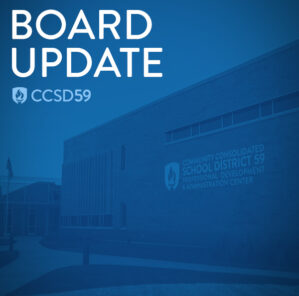Talent Development Program (TDP)
Programa de desarrollo de talento (TDP)
District 59 believes that intellectually gifted and talented students possess unique abilities and/or potential ranging across a wide spectrum of development. It is the district’s responsibility, in conjunction with parents and community stakeholders, to nurture and advance students’ academic talents.
what is the talent development PROGRAM (tdp)?
Identified students in grades three through five receive services in math, reading, or both depending on their area(s) of academic strength using a pull-out model. Students leave their class during a portion of their classroom math or reading practice to come to the TDP teacher’s classroom to work with other students on lessons in the same subject area with a focus to help them advance beyond grade level standards. Students receive this instruction for a minimum of 90 minutes per week per subject.
TDP teachers also deliver critical and creative thinking skills lessons to all second grade students using a whole-class teaching model as they partner with classroom teachers to expose all students to high level and rigorous thinking.
what are the benefits?
- Students’ abilities are validated
- Students are able to work at a faster pace and at a level that meets their intellectual needs
- Students are able to collaborate and learn with peers who have similar ability levels, interests, struggles, and strengths
- Students’ unique social and emotional needs can be focused on
tdp program UNDERLYING BELIEFS
- Gifted and talented students exist in all age, gender, cultural, ethnic, and socio-economic groups.
- Gifted and talented students learn differently and require special provisions, experiences, and services not provided for in the regular instructional program.
- Gifted and talented students need opportunities to interact with their intellectual peers as well as a wide variety of individuals and groups to promote their cognitive, academic, social and emotional needs.
- It is a shared responsibility of caretakers, teachers, staff, and administrators to collaborate so gifted and talented students are recognized, valued, challenged, and nurtured.
You can find more specific information regarding the TDP program below.
IDENTIFICATION
Primary (Grades K-2)
In an effort to nurture talent in grade K-2, students may be provided enrichment services that may vary by building and year to year based on needs of the students. These enrichment sessions may take place in the whole-group setting or in small groups and are facilitated by the TDP resource teacher.
Intermediate (Grades 3-5)
Formal identification of students entering the program begins in third grade. District 59 assesses students with i-Ready (computer-adaptive measure) in reading and math and the Cognitive Abilities Test (CogAT). Both tests are nationally standardized and are used as universal screeners in the district. The iReady assessment is administered three times a year. The CogAT is administered in the spring of second and fourth grades.
Formal identification is based on the scores from the aforementioned assessments in the areas of reading and mathematics, along with teacher/staff input through the HOPE Rating Scale. Once this information is collected, local norms are calculated so students are compared to other students in our district as opposed to the nation. Student scores are then placed into a TDP eligibility matrix in the categories of ability (CogAT), achievement (iReady), and performance (HOPE). The TDP program targets students who place in the top 15% based on local norms for placement into the program.
Diagnostic Data
This is used to show level of mastery and need for services:
-
- District 59 uses universal screening, which means all students take the same tests
- Data from two standardized tests are used to help determine if students might benefit from TDP services: i-Ready and the Cognitive Ability Test (CogAT); both of these assessments measure math and reading skills but in very different ways. (Contact your school’s TDP teacher for further details and about the difference between ability and achievement) The CogAT also assesses a student’s nonverbal skills, which is used specifically for identification of English Learners. A student’s Quantitative/Nonverbal partial composite can be used for qualification of math TDP services.
- Input from staff about academic performance and social characteristics using the HOPE (Having Opportunities Promotes Excellence) Rating Scale
- Triangulation of Data: TDP staff reviews data from our two sources and input from staff to determine which students meet the established district criteria for services in their area(s) of strength
- Once all of this information is collected, school norms are calculated so students are compared to other students in their school as opposed to the nation or District, which is what the CogAT report shows. Student scores are then placed into a TDP eligibility matrix in the categories of ability (CogAT), achievement (i-Ready), and performance (HOPE). The TDP program targets students who place in the top 15% based on school norms for placement into the program. (Contact your school’s TDP teacher for further details regarding the rationale for using school norms)
- We acknowledge there is more to students than their test scores so there is a process in place when a situation warrants further conversations such as extreme inconsistencies in data, students who transfer from other Districts and were receiving services in a gifted or advanced program, and students who are twice exceptional, for example.
How will i know if my child qualifies?
A letter from your child’s school, explaining which services your child qualifies for, will be sent home from the school principal and TDP Teacher. Services will begin within two weeks upon receipt of the signed letter from you granting permission to service your child. An overview of services will be provided to caregivers.
can a student with disabilities qualify?
Yes. If data indicate a student qualifies for TDP services and the child also has an Individualized Education Plan (IEP) or 504 plan, the student is considered twice-exceptional (2e). All accommodations and modifications listed in the IEP or 504 plan will be put in place in TDP.
what if my child does not qualify for services but I think they should?
We welcome you to bring any information to support your position to your child’s classroom teacher, the building principal, and/or the school’s TDP teacher. From that point, a communication will be sent home based on the information you provide once it has been reviewed, and next steps can be proposed. CogAT retests, while granted in some cases, are complex decisions that require in-depth conversations before consideration is given.
If my child was receiving gifted or TDP services at their previous school, do they automatically qualify for TDP services?
Students new to District 59 that were in a gifted program at the time of their move will undergo a data and information review. The TDP teacher will review all applicable documentation showing that the child was participating in the previous district’s gifted program, look into the type of programming the child was receiving, and analyze the child’s previous test scores. If the child took similar achievement and ability tests to ours and the results are less than one calendar year old, these results may be considered for eligibility for services. If the new student meets District 59’s TDP criteria, it may be found that the student will benefit from services and therefore qualify without further testing or data collection. This decision will be made with input from the District’s Executive Director of Curriculum and Instruction. Students who transfer schools within District 59 who were receiving services through the TDP will continue to receive those services at the new school, as long as the services remain beneficial to the child.
what curriculum is used?
A comprehensive framework for both math and reading is based on Common Core State Standards (CCSS) and District Outcomes. It has been designed by the TDP teaching staff and is regularly updated and modified to meet the changing needs of the students. The curriculum is leveled and can be differentiated and modified in order to assist students to further develop their individual interests, needs, and abilities.
How will I receive information about my child’s progress?
A Progress Report will be sent home twice a year; once in early winter and again on the last day of school. This Report is narrative in style with the exception of Work Habits and Social and Emotional Learning, which are denoted with the same indicators as the standard grade level report card: Consistently Demonstrates (CD); Developing (DV); Not Yet (NY).
Who do I contact about Tdp services at my school?
General questions can be answered by the office staff but more specific questions are best directed to the building principal and/or TDP Teacher.
are there tdp services at every school?
Yes, in each of the eleven elementary schools, taught by a half time certified teacher whose role is specific to meeting the needs of identified students as well as helping to develop talent in students who have not yet met the criteria for qualification by assisting classroom teachers, along with talent development for all second graders.
Do students need to re-qualify for services through the TDP each year?
As long as the need is there and the student is benefitting, there is no need for a student to re-qualify for services each year. If services no longer seem to be benefitting a child, conversations will begin and meetings will be held, including with the child and the caregiver.
Are there TDP services at the Junior High Schools?
No. At the end of fifth grade, students are selected for sixth grade advanced classes based on performance on the fifth grade iReady, Cognitive Abilities Test, and recommendations from the classroom teachers and the elementary TDP Resource Teacher. The advanced curriculum at the junior high is delivered during Language Arts and Mathematics classes. TDP.
is there an exit policy?
While there is no formal Exit Policy, there are rare occasions when Talent Development Services are no longer benefitting the student. In these cases, there is a process that begins with conversations between the person questioning the benefit and anyone who works with the student, potentially including the student themselves. If there is no resolution and actions have been attempted with no improvement, conversations with the TDP Teacher Leader take place, likely then the student’s parent. Decisions to pause or cease TDP services are approved by the Executive Director of Curriculum and Instruction prior to being finalized with caregivers and students.
El Distrito 59 cree que los estudiantes intelectualmente dotados poseen habilidades únicas y/o potenciales que abarcan un amplio espectro de desarrollo. Es responsabilidad del distrito, junto con los padres y las partes interesadas de la comunidad, nutrir y mejorar los talentos académicos de los estudiantes.
¿Qué es el PROGRAMA de Desarrollo de Talento (TDP)?
Los estudiantes identificados en los grados tres a cinco reciben servicios en matemáticas, lectura o ambos dependiendo de su(s) área(s) de fortaleza académica utilizando un modelo donde salen del salón. Los estudiantes salen de su clase durante una parte de su práctica de matemáticas o lectura en el salón de clases para ir al salón de clases del maestro de TDP para trabajar con otros estudiantes en lecciones en la misma materia con un enfoque para ayudarlos a avanzar más allá de los estándares de nivel de grado. Los estudiantes reciben esta instrucción por un mínimo de 90 minutos por semana por materia.
Los maestros de TDP también brindan lecciones de habilidades de pensamiento crítico y creativo a todos los estudiantes de segundo grado utilizando un modelo de enseñanza para toda la clase mientras se asocian con los maestros de clase para exponer a todos los estudiantes a un pensamiento riguroso y de alto nivel.
¿Cuales son los beneficios?
- Se validan las habilidades de los estudiantes
- Los estudiantes pueden trabajar a un ritmo más rápido y a un nivel que satisfaga sus necesidades intelectuales
- Los estudiantes pueden colaborar y aprender con compañeros que tienen niveles de habilidad, intereses, luchas y fortalezas similares
- Se pueden enfocar en las necesidades sociales y emocionales únicas de los estudiantes
CREENCIAS SUBYACENTES DEL PROGRAMA DE TDP
- Los estudiantes dotados y talentosos existen en todas las edades, géneros, grupos culturales, étnicos y socioeconómicos
- Los estudiantes dotados y talentosos aprenden de manera diferente y requieren disposiciones, experiencias y servicios especiales que no se brindan en el programa de instrucción regular
- Los estudiantes dotados y talentosos necesitan oportunidades para interactuar con sus pares intelectuales, así como con una amplia variedad de individuos y grupos para promover sus necesidades cognitivas, académicas, sociales y emocionales
- Es una responsabilidad compartida de los cuidadores, maestros, personal y administradores colaborar para que los estudiantes dotados y talentosos sean reconocidos, valorados, desafiados y educados
Puede encontrar información más específica sobre el programa TDP a continuación.
IDENTIFICACIÓN
Primaria (Grados K-2)
En un esfuerzo por fomentar el talento en los grados K-2, los estudiantes pueden recibir servicios de enriquecimiento que pueden variar según el edificio y año tras año según las necesidades de los estudiantes. Estas sesiones de enriquecimiento pueden tener lugar en el entorno de todo el grupo o en grupos pequeños y son facilitadas por el maestro de recursos de TDP.
Intermedia (Grados 3-5)
La identificación formal de los estudiantes que ingresan al programa comienza en el tercer grado. El Distrito 59 evalúa a los estudiantes con i-Ready (medida adaptativa a la computadora) en lectura y matemáticas y la Prueba de Habilidades Cognitivas (CogAT). Ambas pruebas están estandarizadas a nivel nacional y se utilizan como filtros universales en el distrito. La evaluación iReady se administra tres veces al año. CogAT se administra en la primavera de segundo y cuarto grado.
La identificación formal se basa en los puntajes de las evaluaciones antes mencionadas en las áreas de lectura y matemáticas, junto con los aportes del maestro/personal a través de la escala de calificación HOPE. Una vez que se recopila esta información, se calculan las normas locales para que los estudiantes se comparen con otros estudiantes en nuestro distrito en lugar de la nación. Luego, los puntajes de los estudiantes se colocan en una matriz de elegibilidad de TDP en las categorías de capacidad (CogAT), logro (iReady) y desempeño (HOPE). El programa TDP se dirige a los estudiantes que se ubican en el 15% superior según las normas locales para la ubicación en el programa.
Datos de diagnóstico
Esto se usa para mostrar el nivel de dominio y la necesidad de servicios:
-
- El Distrito 59 usa evaluación universal, lo que significa que todos los estudiantes toman las mismas pruebas
- Los datos de dos pruebas estandarizadas se usan para ayudar a determinar si los estudiantes podrían beneficiarse de los servicios de TDP: i-Ready y la Prueba de Habilidad Cognitiva (CogAT); ambas evaluaciones miden las habilidades matemáticas y de lectura, pero de maneras muy diferentes. (Comuníquese con el maestro de TDP de su escuela para obtener más detalles y sobre la diferencia entre capacidad y rendimiento). El CogAT también evalúa las habilidades no verbales de un estudiante, que se usa específicamente para identificar a los estudiantes de inglés. El compuesto parcial cuantitativo/no verbal de un estudiante se puede usar para calificar los servicios TDP de matemáticas.
- Información del personal sobre el desempeño académico y las características sociales utilizando la escala de calificación HOPE (Por sus siglas en inglés – Tener oportunidades promueve la excelencia)
- Triangulación de datos: el personal de TDP revisa los datos de nuestras dos fuentes y la información del personal para determinar qué estudiantes cumplen con los criterios establecidos por el distrito para los servicios en su área(s) de fuerza
- Una vez que se recopila toda esta información, se calculan las normas escolares para que los estudiantes se comparen con otros estudiantes en su escuela en lugar de la nación o el Distrito, que es lo que muestra el informe CogAT. Luego, los puntajes de los estudiantes se colocan en una matriz de elegibilidad de TDP en las categorías de capacidad (CogAT), logro (i-Ready) y desempeño (HOPE). El programa TDP se dirige a los estudiantes que se ubican en el 15% superior según las normas escolares para la ubicación en el programa. (Comuníquese con el maestro de TDP de su escuela para obtener más detalles sobre las razones para usar las normas escolares)
- Reconocemos que hay más en los estudiantes que sus puntajes en las pruebas, por lo que existe un proceso cuando una situación justifica conversaciones adicionales, como inconsistencias extremas en los datos, estudiantes que se transfieren de otros distritos y recibían servicios en un programa para dotados o avanzados, y estudiantes que son dos veces excepcionales, por ejemplo.
¿Cómo sabré si mi hijo califica?
El director de la escuela y el maestro de TDP enviarán a casa una carta de la escuela de su hijo, explicando para qué servicios califica su hijo. Los servicios comenzarán dentro de las dos semanas posteriores a la recepción de la carta firmada por usted que otorga el permiso para atender a su hijo. Se proporcionará una descripción general de los servicios a los cuidadores.
¿Puede un estudiante con discapacidades calificar?
Sí. Si los datos indican que un estudiante califica para los servicios de TDP y el niño también tiene un Plan de Educación Individualizado (IEP, por sus siglas en inglés) o un plan 504, el estudiante se considera doblemente excepcional (2e). Todas las adaptaciones y modificaciones enumeradas en el IEP o el plan 504 se implementarán en TDP.
¿Qué sucede si mi hijo no califica para los servicios pero creo que debería?
Lo invitamos a traer cualquier información para respaldar su posición al maestro de clase de su hijo, al director del edificio y/o al maestro de TDP de la escuela. A partir de ese momento, se enviará una comunicación a casa basada en la información que proporcione una vez que se haya revisado, y se pueden proponer los próximos pasos. Las reevaluaciones de CogAT, si bien se otorgan en algunos casos, son decisiones complejas que requieren conversaciones en profundidad antes de que se tomen en consideración.
¿si mi hijo estaba recibiendo servicios para superdotados o tdp en su escuela anterior, califica automáticamente para los servicios TDP?
Los estudiantes nuevos en el Distrito 59 que estaban en un programa para superdotados en el momento de su mudanza se someterán a una revisión de datos e información. El maestro de TDP revisará toda la documentación aplicable que muestre que el niño estaba participando en el programa para superdotados del distrito anterior, investigará el tipo de programación que estaba recibiendo el niño y analizará los puntajes de las pruebas anteriores del niño. Si el niño tomó pruebas de rendimiento y capacidad similares a las nuestras y los resultados tienen menos de un año calendario, estos resultados pueden considerarse para la elegibilidad para los servicios. Si el nuevo estudiante cumple con los criterios TDP del Distrito 59, se puede determinar que el estudiante se beneficiará de los servicios y, por lo tanto, calificará sin más pruebas o recopilación de datos. Esta decisión se tomará con el aporte del Directora Ejecutiva de Currículo e Instrucción del Distrito. Los estudiantes que se transfieren de escuela dentro del Distrito 59 que estaban recibiendo servicios a través del TDP continuarán recibiendo esos servicios en la nueva escuela, siempre y cuando los servicios sigan siendo beneficiosos para el niño.
¿Qué plan de estudios se utiliza?
Un marco integral para matemáticas y lectura se basa en los Estándares Estatales Básicos Comunes (Common Core State Standards) (CCSS, por sus siglas en inglés) y los Resultados del Distrito. Ha sido diseñado por el personal docente de TDP y se actualiza y modifica regularmente para satisfacer las necesidades cambiantes de los estudiantes. El plan de estudios está nivelado y se puede diferenciar y modificar para ayudar a los estudiantes a desarrollar aún más sus intereses, necesidades y habilidades individuales.
¿Cómo recibiré información sobre el progreso de mi hijo?
Se enviará a casa un informe de progreso dos veces al año; una vez a principios de invierno y otra vez el último día de clases. Este informe tiene un estilo narrativo con la excepción de los hábitos de trabajo y el aprendizaje social y emocional, que se indican con los mismos indicadores que la boleta de calificaciones de nivel de grado estándar: Demuestra consistentemente (CD, por sus siglas en inglés); en desarrollo (DV, por sus siglas en inglés); Todavía no (NY, por sus siglas en inglés).
¿Con quién me comunico acerca de los servicios de Tdp en mi escuela?
Las preguntas generales pueden ser respondidas por el personal de la oficina, pero es mejor dirigir las preguntas más específicas al director del edificio y/o al maestro de TDP.
¿Hay servicios de tdp en todas las escuelas?
Sí, en cada una de las once escuelas primarias, enseñado por un maestro certificado de medio tiempo cuya función es específica para satisfacer las necesidades de los estudiantes identificados, así como para ayudar a desarrollar el talento en los estudiantes que aún no han cumplido con los criterios de calificación al ayudar a los maestros del salón, junto con el desarrollo de talentos para todos los estudiantes de segundo grado.
¿Los estudiantes necesitan volver a calificar para los servicios a través del TDP cada año?
Mientras exista la necesidad y el estudiante se esté beneficiando, no hay necesidad de que un estudiante vuelva a calificar para los servicios cada año. Si los servicios ya no parecen beneficiar a un niño, se iniciarán conversaciones y se llevarán a cabo reuniones, incluso con el niño y el cuidador.
¿Hay servicios de TDP en las Escuelas preSecundarias?
No. Al final del quinto grado, los estudiantes son seleccionados para las clases avanzadas de sexto grado en función del rendimiento en la prueba de habilidades cognitivas iReady de quinto grado y las recomendaciones de los maestros de clase y el maestro de recursos TDP de primaria. El plan de estudios avanzado en la presecundaria se imparte durante las clases de lengua y literatura y matemáticas.
¿Existe una política de salida?
Si bien no existe una política de salida formal, existen raras ocasiones en las que los servicios de desarrollo de talentos ya no benefician al estudiante. En estos casos, hay un proceso que comienza con conversaciones entre la persona que cuestiona el beneficio y cualquiera que trabaje con el estudiante, incluyendo potencialmente al estudiante mismo. Si no hay resolución y se han intentado acciones sin mejorar, se llevan a cabo conversaciones con el Líder de maestros de TDP, probablemente luego con el padre del estudiante. Las decisiones de pausar o cesar los servicios de TDP son aprobadas por la Directora Ejecutiva de Currículo e Instrucción antes de ser finalizadas con los cuidadores y los estudiantes.




